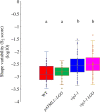Sepal shape variability is robust to cell size heterogeneity in Arabidopsis
- PMID: 38807547
- PMCID: PMC11285780
- DOI: 10.1098/rsbl.2024.0099
Sepal shape variability is robust to cell size heterogeneity in Arabidopsis
Abstract
How organisms produce organs with robust shapes and sizes is still an open question. In recent years, the Arabidopsis sepal has been used as a model system to study this question because of its highly reproducible shape and size. One interesting aspect of the sepal is that its epidermis contains cells of very different sizes. Previous reports have qualitatively shown that sepals with more or less giant cells exhibit comparable final size and shape. Here, we investigate this question using quantitative approaches. We find that a mixed population of cell size modestly contribute to the normal width of the sepal but is not essential for its shape robustness. Furthermore, in a mutant with increased cell and organ growth variability, the change in final sepal shape caused by giant cells is exaggerated but the shape robustness is not affected. This formally demonstrates that sepal shape variability is robust to cell size heterogeneity.
Keywords: growth; morphogenesis; paf1c; reproducibility; variability.
Conflict of interest statement
We declare we have no competing interests.
Figures



References
Publication types
MeSH terms
Grants and funding
LinkOut - more resources
Full Text Sources
